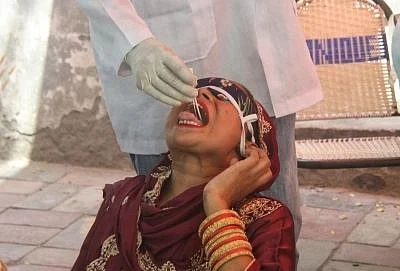At a time when most states in India have managed to lower their coronavirus case counts, Kerala still continues to see a high number of COVID-19 cases. On Tuesday, 10 August, the Centre said at a briefing that Kerala contributed to over 50 percent of the country's COVID cases.
In order to help the local administration in curbing the virus spread, the Centre in early July had sent a multidisciplinary team to the state.
Last week, Dr Sujeet Kumar Singh, Director, National Centre for Disease Control, who was part of the team, submitted a detailed report regarding this to the Centre, The Indian Express reported.
'Kerala Faces Nine Unique Challenges in Controlling Virus Spread'
In the report, Sujeet Singh pointed out that Kerala was finding it difficult to control the coronavirus spread as it faces nine unique challenges.
One major challenge, Dr Sujeet pointed out, was that in Kerala, intra-house transmission was high. "The rural-urban divide is very faint (in Kerala). Like we see in North Indian states, especially in high population density states, farmlands create a natural barrier for virus spread," Singh said as quoted by The Indian Express.
He added that efficient home-isolation was not taking place in Kerala, as houses there are spread in a linear manner.
Kerala is witnessing a large number of reinfections. More specifically, reinfections are occurring among the people who have received both doses of the vaccine.
Meanwhile, Home Ministry sources told NDTV that over 40,000 'breakthrough cases' (infection after vaccination) have been reported in Kerala.
High prevalence of Non-Communicable Diseases (NCD) is yet another factor responsible for higher disease spread in the state. Singh said that nearly 30 percent of the people in Kerala have NCDs.
As Kerala has high life expectancy, it has a higher proportion of those who are easily susceptible to the virus.
Massive migration of people from within India and abroad is another cause for the virus spike, he said, adding that strict 'public health measures' like local lockdowns have to be put in place to break the disease transmission in Kerala, the NCDC chief said.
There is 90 percent prevalence of highly contagious Delta variant in Kerala.
Kerala has also not defined containment zones according to Centre's guidelines. Containment zone and non-containment zones were not demarcated by buffer zones, Singh further said, Hindustan Times reported.
According to the report, Kerala reviewed its containment classification as per seven-day moving average but it actually takes 14 days, Singh said.
Although, the state meticulously tracked and traced new COVID infections, it had no measure to stop transmission.
The NCDC chief further cited the unlocking process, relaxations for tourism and the impending Onam festival as factors leading up to a 'challenging scenario'.
He went on to predict a cumulative incidence of 4.62 lakh cases in Kerala approximately with 95 percent CI (Confidence Interval) between 1 and 20 August.
No Mass Gatherings Allowed for Onam, Muharram
The Kerala government on Tuesday announced that no mass gatherings would be allowed in the state during the upcoming festivals - Onam, Muharram, Janmashtami, Ganesh Chaturthi, and Durga Pooja.
The decision was taken by Disaster Management Department of Kerala, following Centre's alert to all states about the possibility of mass gatherings at festivals turning into super-spreaders of COVID-19.
The state has also announced that virus testing will be increased at places where the spread of the disease is critical.
At the same time, from 12 August, special intensified stringent lockdown restrictions will be enforced at panchayats and urban wards, that have 'critical' infection spread and Weekly Infection Population Ration (WIPR) over eight.
Meanwhile, a maximum of 15,000 devotees will be allowed per day to Sabarimala hill shrine from 15 August.
What Restrictions Are There in Kerala?
Kerala has also said that people who have not yet received a single dose of vaccine or do not posses a negative RT-PCR test that is taken within 72 hours or those who have not been infected by COVID in the past one month, can move out for essential activities.
The state had earlier said that people will be allowed to enter shops, markets, banks, and tourist spots only if they have taken at least one dose of the vaccine or are in possession of RT-PCR negative certificates taken within the last 72 hours.
The government has further announced that total lockdowns will be observed on all Sundays except on 15 August and 22 August in view of Independence day and Onam, respectively.
A maximum of 40 people will be allowed to visit places of worship that has a large built-up area. And a maximum of 20 people will be allowed for marriages and deaths.
Meanwhile, on Monday, 9 August, the state opened all its tourist places in view to improve its economic activity. State tourism minister P A Muhammed Riyas said that people who have taken at least one dose of vaccine would be allowed to stay in hotels and resorts.
Notably, in July, Kerala had received flak from different quarters, including the Indian Medical Association (IMA), for easing COVID-19 restrictions for three days ahead of Eid. The Supreme Court had also pulled up the state and said its decision to allow shops to reopen for a whole day on 19 July, at areas where positivity rate is more that 15 percent, showed a 'sorry state of affairs'.
Kerala COVID Case Tally
Kerala has been reporting close to 20,000 COVID cases daily, for the past few days. On Wednesday, 11 August, it reported 23,500 new virus cases and 116 deaths. The state currently has over 1.71 lakh active cases. The state has so far witnessed 18,004 deaths.
The state's weekly average test positivity rate is 13.48 percent and it has vaccinated 43.44 percent of its total population.
(With inputs from The Indian Express, Hindustan Times, and NDTV)
(At The Quint, we question everything. Play an active role in shaping our journalism by becoming a member today.)
